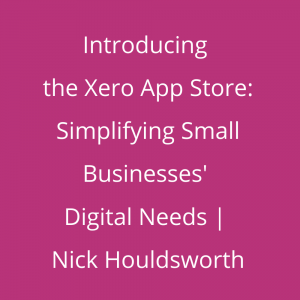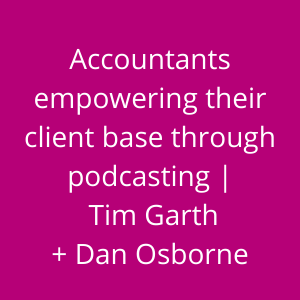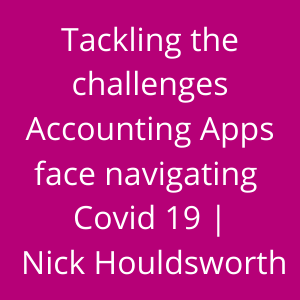Accountancy is not just about regurgitating the facts and data but figuring out what they mean and why they matter to our clients.
I went for a long walk this morning with my dog Charlie, and I realised towards the end of the walk – I did not have my step counter with me. Deflated I thought well this has been a waste of time. My statistics for the week would not reflect the walk. My weekly averages would be impacted, and my forgetfulness may negatively impact my motivation for staying focused on my fitness regime. Then I started wondering – how I could hack my step counter, and if I did, how many steps would I enter?
Of course, the health benefits of the walk were still the same. Technically I could manually update the data. What I was really worried about was my motivation and falling off the fitness wagon.
As accountants, we love to be able to provide a clean financial report, regurgitating accurate facts and data about businesses. Yes, this is the basics of what most businesses want from their accountant. But they want more. They want to know what the financial reports mean and why they matter to them.
What information from financial reports can be extracted, and shared with the business to both motivate the business team, and give them confidence.
Motivation and confidence.
On the weekend, when I did, in fact, remember to take my step counter, I clocked up forty kilometres walking. That’s just shy of the distance of a marathon. The statistics let me know that potentially I could cope with a marathon giving me motivation, and gave me the confidence to contemplate upping my game!
Pulling this back into the business, what do the numbers mean, why do they matter, how can I work with the client to motivate them and enhance their confidence.
With a clean set of financial reports – how can the accountant further help the client?
Sometimes I think accountants are reluctant to offer advisory support – because they feel there’s an expectation that they should be able to solve all of the small business owners problems. A doctor can not solve all of a patients problems. They can educate them, empower them, and potentially refer them to a specialist. Likewise, an accountant can not solve the problem but is extremely well placed to provide useful advice. So rather than leaping into advisory work, take a few small steps, that is completely within both your and your client’s comfort zone.
Start by allowing some time during the communication process to ask your clients some open ended questions.
- What are the clients long term and short business goals?
- What are the client’s pain points or concerns in their business?
- Are they anticipating any significant staffing changes?
- Are there aspects of the financial reports I can further explain to you?
Listen to your client, ask for further details and clarification, make notes and action points during the meeting. Identify if you have internal resources that can further support the client or businesses within your network that you can connect the client with.
A detailed review of the elements of the accounts
Moving from the macro discussions, you could talk to a client about specific areas of their business. For example, if you were to have a discussion on how clients could minimise their expenses, here are a few points you could address.
- Review annual expenses and extrapolate with the client what each of the expenses is covering. Is the expense amount fair, reasonable and what they expected. I’ve heard of situations where the internal staff working for builders have pushed their own personal renovation bills fraudulently through the business.
- Review annual expenses and identify if any account line is significantly greater than the rest. Assuming the information is accurate – consider further splitting out the detail for future reporting.
- Identify if there have been any major changes in annual expenses for the past 3 – 5 years and if they warrant further inspection.
- With an understanding of the business operations – are there any expenses that are unexpectedly missing? Have directors been paid appropriately? Has the rent been processed through the accounts? Sometimes in smaller family businesses – they can have unorthodox ways of dealing with transactions.
- Use a bills and scanning solution like Receipt Bank to extract data from supplier invoices and push details into the accounting solution (QBO, MYOB, or Xero). This ensures the accounting solution has the supplier documents attached and enables the business to manage cash flow by planning when payments will be made.
- Integrate your clients accounting solutions with the cloud solution ExpenseCheck. It undertakes a real time analysis of electricity, insurance and telecom bills and advises if cheaper options are available. This can initiate an informed review of the expense.
- Review the Receipt Bank Top 10 Suppliers list, which is the third tab under the Suppliers tab from the main It highlights who the business is frequently spending money with (not the volume of money). With this information, the client may be able to explore discount opportunities. For example, if they realised there were many parking bills, could they explore renting a car parking space, or pre-booking car- parking and benefitting from the discounted prices.
Small businesses are made up of many elements, and each has an impact on another area. If for instance, you review expenses and decide to reduce the marketing budget for a client, that may impact the quantity and quality of clients they attract in the months to come. Or reducing the packaging costs, may result in damaged deliveries, and increase the number of refunds that require processing. When reviewing expenses, it’s necessary to consider the knock on the impact it may have in other areas.
What business data can regularly be reviewed on a business intelligence dashboard to ensure the business team stays motivated and has the confidence to stay focused on their journey.
If the client is keen to understand if they can take on bigger project work – review their data for past project performance, and use it to assist in predicting future outcomes. As it stands, the accounting records may not reveal accurate insights and may require massaging or adoption of new business processes. The first step is to identify existing and ongoing projects and ensure they are being tracked. QBO, MYOB and Xero all contain the ability to track jobs to some degree under various guises. A simple, low-cost solution for clients with a few consultants using corporate cards is to use an expense management and tracking solution like Expensify to assign expenditure to different projects. It streamlines the expense report process and enhances the accuracy of the project data. Complex project tracking requirements may require a full-blown solution. It’s necessary to assess the cost of obtaining the data versus the accuracy of the data.
What does the project data mean and why does it matter?
I worked with a client who decided to close one project division of his business because it had been performing poorly for two years, and nothing he could do seemed to turn it around. His gut could not understand why it was performing poorly – But the black and white financials said it was. Literally, moments before he pulled the plug I was called in to explain why the project division was losing money. Upon review, I identified import costs had consistently been incorrectly allocated. Instead of losing cash, it was, in fact, generating a healthy profit.
The incorrect data had demotivated the team for two years. The client was in such emotional turmoil about this realisation. He did not have the energy to maintain the division. Instead of closing it, he sold it off.
It’s a depressing story, highlighting how financial data can impact a business team’s motivation and choices.
If a business has access to accurate project financials, they have insights about whether the type of work is profitable, they, are equipped to understand if they increase dedicated resources, such as advertising budget or additional staff, they may be better placed to leverage and focus growth in the project area.
Maintaining the accuracy and integrity of my step counter gives me the motivation and confidence to explore longer walks, and take on greater challenges, which has a knock-on result of improving my health. Accountancy is not just about regurgitating the facts and data but figuring out what they mean and why they matter to our clients.
First appeared on the Public Accountant 5 Jan 2018






